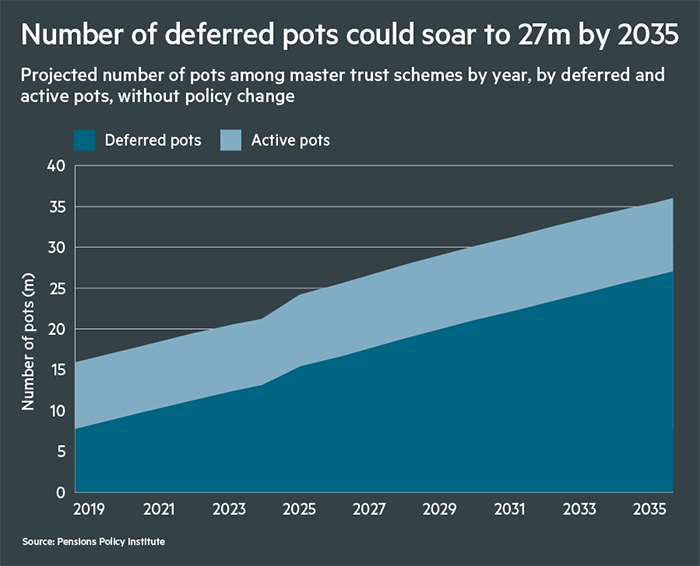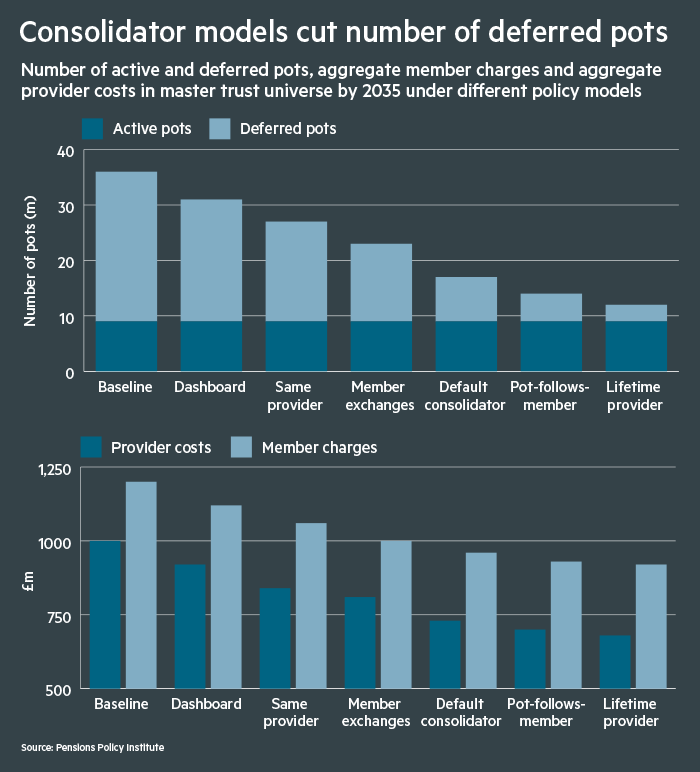Data crunch: Experts have decried the radical solution to the small pots’ crisis, a pension for life, despite the threat that sub-scale funds could overwhelm the UK system.
Without urgent reform, the number of deferred pots could grow from 8m to a problematic 27m by 2035.
Indeed, according to Pensions Policy Institute research, a £100 pot, deferred at age 22, with an annual flat-fee charge of £20 and an annual management charge of 0.25 per cent, would be eroded to zero before the member reaches state pension age at 68.
A pot for life could stifle competition and innovation, with people finding out too late that a decision taken on their behalf when they were 22 is impacting them 40 years later — and not in a good way
Steve Goddard, Salvus Master Trust
A Department for Work and Pensions press release on September 22 announced the formation of a working group to address the problem, but gave no clues as to which options were under consideration.
A PPI research paper ‘Small pots: What they are and why they matter’, published at the same time, outlines three possible options. Pot-follows-member, where members move existing savings to the new employer’s scheme when they change, was considered; along with consolidation of pots within schemes — members with more than one pot in a scheme have these automatically consolidated; and a more radical lifetime scheme, where members contribute into one pot throughout their working life.
According to PPI modelling, the lifetime provider option is the cheapest solution, and would see the number of deferred pots dramatically fall to 3m by 2035, with total deferred member and provider costs decreasing to £920m. 
The much-heralded pot-follows-member solution would see deferred members drop to 5m, with costs of £930m. The default consolidator model would see 8m deferred members and costs of £960m.
Member exchange, a simpler version of pot-follows-member, would see 14m deferred members with £1bn in costs. Same-provider consolidation would cost £1.06bn with 18m deferred pots. The status quo would see total deferred member costs of £1.2bn.
Every solution has potential drawbacks as well as advantages. Same-provider consolidation would lead to “cherry-picking” of employees by providers, according to the PPI.
Pot-follows-member could see people transferring into higher-charging products, while a lifetime provider could lead to unfair competitive advantages, increased burdens for employers and a struggle for the Pensions Regulator to ensure auto-enrolment compliance. However, proposals for the introduction of auto-enrolment in Ireland are based on a lifetime provider model.
Would a pension for life work in the UK?
But would a lifetime pension work for the UK? Experts largely poured scorn on this most radical idea.
“There are real dangers if providers are competing to be the lifetime provider of each individual employee,” warns Steve Webb, partner at LCP.
“Evidence from Australia suggests that this will drive up marketing and acquisition costs, and this will be to the detriment of members.
“In addition, the current system is based heavily around cross-subsidy, as providers make money from higher earners and this helps to cover the cost of loss-making provision for lower earners in the same workplace. If providers and platforms can cherry-pick high earners, lower earners are likely to get a worse deal,” Sir Steve adds.
Steve Goddard, co-founder of Salvus Master Trust, says: “Employers still like to determine who is their pension provider, technology doesn’t develop overnight to sort the payroll issue, and there is the issue of getting stuck with a duff provider.
“Of the three, the last may be the thorniest for the government. A pot for life could stifle competition and innovation, with people finding out too late that a decision taken on their behalf when they were 22 is impacting them 40 years later — and not in a good way.” 
Renny Biggins, head of retirement at The Investing and Saving Alliance, echoes this sentiment: “The initial pension scheme entered into, or the pre-chosen consolidator, may offer value for money at the time the decision is made but may not continue to do so over time. Similarly, value for money is subjective and will change for an individual at different stages of life.”
David Robbins, senior consultant at Willis Towers Watson, notes: “If individuals chose their own pension provider, this would be partly on the basis of brand awareness.
“You could expect to see a lot more TV adverts, billboards and the like advertising pension providers, the cost of which would ultimately have to be recouped through charges paid by pension savers.”
Introducing lifetime providers would be a significant break with the past, and this would come at a cost but may help boost engagement.
Kate Smith, head of pensions at Aegon, points to members seeing “their lifetime pension pot grow steadily as they move from job to job”.
She adds: “There are big issues around how the lifetime provider is chosen — is this the first scheme the member is auto-enrolled into with their first employer? What happens if the employee is unhappy with this scheme, how will they know that it provides value for money, and how can they find an alternative lifetime provider?”
No silver bullet
Of the alternatives, Mr Goddard favours the Australian option of “a small pots’ dustbin, where a specialist provider manages small pots at a higher AMC in excess of the charge cap”.
Mr Robbins too prefers “a single default receiver of genuinely small pots, while leaving individuals to initiate transfers of other deferred pots if they so wish”.
Ros Altmann, a former pensions minister, suggests something similar: “All small pots could be moved into Nest if the individual does not choose their own lifetime provider”.
Most experts back the pot-follows-member approach. Irwin Mitchell partner Penny Cogher says the policy “should be a vote winner for the employees concerned, and it is not good enough for the pensions industry to keep pushing back on this on the basis of cost”.
“The insurers in particular should be expected to subsidise some of these,” Ms Cogher adds.
“There is no silver bullet,” says Pete Glancy, head of pensions policy at Scottish Widows, who warns “the industry may have to acclimatise to a much greater number of loss-making pots as being part of a new normal”.
Adrian Boulding, director of policy at Now Pensions and chair of the DWP Small Pots Working Group’s master trust expert panel, says: “Master trusts have to learn that every widow’s mite is important, however low paid or transient the worker was.
“When we find a way that rolls up all the contributions made for retirement over a working life, then we will have found a way that creates a real second pension of value. And that’s the purpose of auto-enrolment — to get all of us a second pension income to boost the basic state pension in our retirement years.”






















